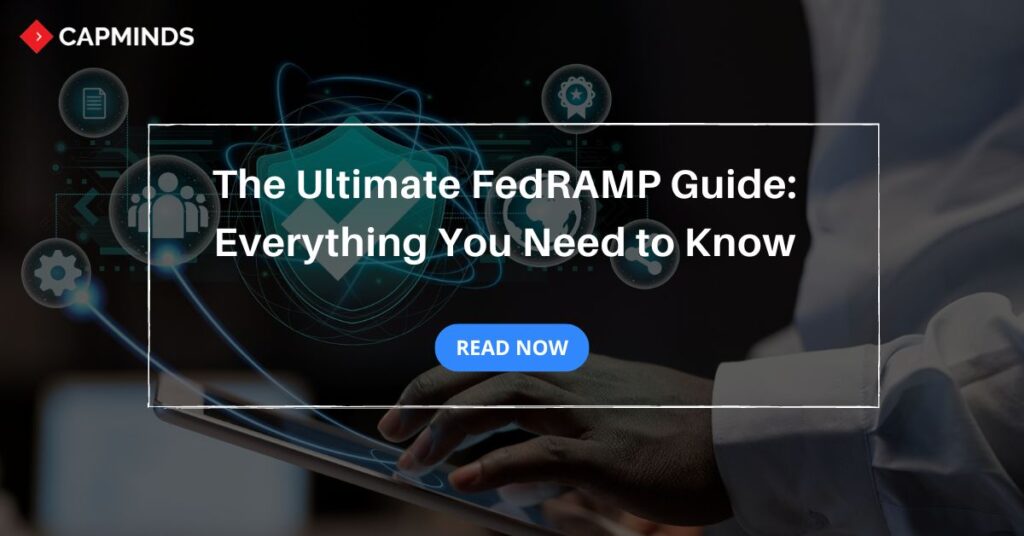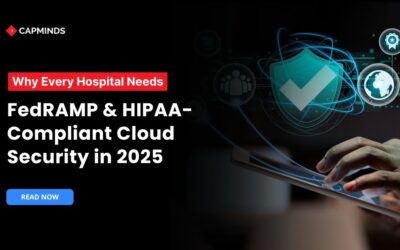The Ultimate FedRAMP Guide: Everything You Need to Know
The US federal government has been promoting cloud-based systems since it was developed in 2011. The Main Aim of this is to make information sharing across the federal government a lot easier. But when it comes to leveraging cloud services or products, it is important to choose the one that meets a certain level of security.
So, the US General Service Administration has hosted the FedRAMP compliance and created it to standardize the authorization, assessment, and monitoring of the cloud-computing services and products used by the federal government. What exactly is the FedRAMP? In this blog, you’ll learn how FedRAMP works, which authorities regulate it, its certification procedure, and key resources for compliance.
What is FedRAMP?
FedRAMP or the Federal Risk and Authorization Management Program has been established formally to control how federal institutions evaluate and approve cloud-based products and services.
This program is developed by the US Government to standardize, risk assessment, and monitor the cloud computing used by the federal government. Following this, it can be said that FedRAMP aims to make it easier for the new acquisitions of cloud solutions by making sure that the cloud vendors have implemented key security provisions before being taken on board by government departments.
Such goals were meant to avoid duplicate work, cutting down costs while enhancing the safety of the federal information system.
The Main Purpose of this program for federal agencies are:
- It was created to standardize security criteria for cloud computing suppliers.
- FedRAMP helps to lower the cost of security assessments for the federal government and agencies.
- It contributes to a consistent method for accessing and authorizing cloud services across many federal agencies.
- FedRAMP Compliance helps to confidently adopt cloud computing technologies.
Major Authorities and Key Stakeholders in FedRAMP
1. Joint Authorization Board
The JAB is a key governance body in the FedRAMP framework. It consists of representatives from:
- Department of Defense
- Department of Homeland Security
- General Services Administration
The JAB is responsible for providing high-level oversight and approving FedRAMP authorizations. It helps to provide federal security for the program and oversees the review of cloud solutions seeking FedRAMP authorization to operate.
2. Office of Management and Budget
The OMB provides the federal policies and regulations for cloud security and those carried by FedRAMP. Its roles include:
- Ensures that FedRAMP aligns with broader federal IT and security strategies.
- Offers direction on how agencies and CSPs should approach FedRAMP compliance.
3. FedRAMP Program Management Office
The FedRAMP PMO handles the day-to-day management of the FedRAMP program. Its responsibilities include:
- Maintains the catalog of authorized cloud solutions.
- Offers support to CSPs and federal agencies on FedRAMP processes and requirements.
- Ensures the program meets its objectives and provides feedback for improvements.
4. National Institute of Standards and Technology
NIST is a crucial part of FedRAMP as it provides the security standards and guidelines upon which the program is based. The key contributions of the NIST includes:
- Outlines the security controls required for FedRAMP compliance.
- Ensures that FedRAMP’s requirements are grounded in well-established security practices.
5. FedRAMP Technical Review Board
The FedRAMP Technical Review Board evaluates the technical components of authorization packages. It:
- Assesses the effectiveness and completeness of security measures provided by CSPs.
- Offers guidance on technical aspects to ensure compliance with FedRAMP standards.
6. Federal CIO Council
The Federal CIO Council advises on IT management and policy, including FedRAMP. Its role includes:
- Helps align FedRAMP with federal IT goals.
- Ensures that FedRAMP meets the needs of federal agencies.
Visit for More – Government Federal
Who Needs FedRAMP Certification?
1. Cloud Service Providers
CSPs offering cloud solutions to federal agencies must obtain FedRAMP certification. This process involves:
- Ensuring that their solutions meet the rigorous security requirements set by FedRAMP.
- Obtaining the necessary ATO from the FedRAMP JAB or a federal agency.
2. Third-Party Assessment Organizations
3PAOs are accredited entities that assess the security controls of cloud solutions.
- Perform the necessary evaluations to validate that CSPs meet FedRAMP requirements.
- Offer detailed reports and recommendations for authorization decisions.
3. Federal Agencies
Federal agencies are required to use FedRAMP-authorized cloud services. Their responsibilities include:
- Ensuring that they use solutions that have been authorized through FedRAMP.
- Monitoring and maintaining the security of the cloud services they use
Benefits of FedRAMP Compliance
FedRAMP Compliance benefits cloud computing vendors and federal agencies in many ways.
- The US Government used to spend billions on cloud services and products which is a huge marketplace of federal agencies as potential clients.
- Making your company unique from other vendors in the marketplace will help to attract non-federal agencies who value high standards of securities.
- The FedRAMP process often leads to improving the overall company’s security.
- Once the vendors get certified, the authorization can be leveraged across multiple federal agencies.
- Due to overlapping controls, work towards additional compliance certifications (such as HIPAA and SOC 2) can be accelerated.
- Federal agencies can ensure that federal data is protected with consistently applied security controls.
- FedRAMP lowers the time and cost of completing redundant agency security assessments by utilizing a “do once, use many times” paradigm. Agencies can reuse authorizations, saving time and money.
- It helps to streamline the procedure for agencies to implement secure cloud solutions.
- Pre-approved cloud service providers and standardized security requirements allow agencies to easily install cloud solutions that fulfill federal regulations.
FedRAMP Compliance Requirements
FedRAMP Compliance has many requirements. To achieve it, a CSP must perform an evaluation, obtain authorization, and keep ongoing cybersecurity measure monitoring to become FedRAMP compliant.
Here are the basic steps to get a FedRAMP Complaint:
1. Getting Ready for FedRAMP
Start with the preparation phase which has two steps for the cloud computing vendors: Readiness Assessment and Pre-Authorization.
Readiness Assessment
The first stage of the preparation for FedRAMP is the Readiness assessment. During the Readiness Assessment step, a CSP may choose to pursue the FedRAMP Ready designation, which is optional for the Agency Authorisation process but strongly recommended.
To obtain the FedRAMP Ready designation, a CSP must conduct a Readiness Assessment of its service offering in collaboration with an accredited Third Party Assessment Organisation (TPAO). The Readiness Assessment Report (RAR) assesses the CSP’s capacity to meet federal security requirements.
For more information, you can check out the FedRAMP Official page.
Pre-Authorization
The Next stage in the preparation process is the pre-authorization.
CSP formalizes its partnership with the agencies in the pre-authorization. It can be done via the requirements outlined here – https://www.fedramp.gov/about-marketplace/.
A CSP also undergoes the authorization process. They make any necessary technical and procedural changes to meet federal security requirements and prepare the security deliverables needed for authorization. In this stage, the CSP should:
- Have a system that is completely built and functional.
- Have a leadership team that is committed and completely on board with the FedRAMP process.
- Submit the CSP Information Form.
- Determine the security categorization of the data that will be placed within the system using the FedRAMP Federal Information Processing Standards (FIPS) 199 Categorisation Template (located in Appendix K of the System Security Plan (SSP) template, along with the guidance of FIPS Pub 199 [PDF – 78KB] and NIST Special Publication 800-60 Volume 2 Revision 1 to correctly categorize their system based on the types of information processed, stored, and transmitted on the system.
Comes to the final stage of the preparation stage is the kick-off meeting. During this kick-off meeting, the CSP and agency will discuss the:
- Cloud services background and functionality
- The cloud service’s technical security, which includes the data flows, system architecture, authorization border, and basic security capabilities
- Controls accountable to the customer that the Agency must install and test
- Gaps in compliance and corrective actions
- A breakdown of the work, benchmarks, and future actions
1. Securing Authorization
The Second stage of FedRAMP Compliance is securing authorization. This stage involves two steps which are full security assessment and agency authorization process.
Full Security Assessment
The 3PAO conducts a separate system audit as part of the Full Security Assessment phase. Following testing, the 3PAO creates a Security Assessment Report (SAR) that includes a recommendation for FedRAMP Authorisation along with a detailed report on testing results.
The 3PAO’s comments will be incorporated into the CSP’s Plan of Action and Milestones (POA&M), which describes a strategy for addressing the testing results and is based on the SAR findings.
Agency Authorization Process
The agency reviews the security authorization package at this step, and it can include a SAR debrief. CSP remediation might be necessary based on the agency’s review’s findings. The agency may implement, record, and test customer-responsible controls during this phase.
As an alternative, the agency may decide to carry out these actions following the issuance of the ATO. Lastly, after doing a risk analysis and accepting the risk, the agency provides an ATO.
The agency’s risk tolerance is the basis for this choice. The following procedures are followed to complete this stage after an agency issues an ATO letter approving the use of the CSO:
- Except for the security assessment materials, the CSP uploads the Authorisation Package Checklist and the entire security package—which includes the SSP and its attachments, the POA&M, and the Agency ATO letter—to FedRAMP’s secure repository.
- The 3PAO uploads to FedRAMP’s secure repository all security assessment materials (SAP, SAR, and attachments) related to the CSO security package.
The security assessment materials are reviewed by the FedRAMP PMO before being added to the FedRAMP Marketplace. The service offering’s FedRAMP Marketplace listing will be updated with the authorization date and FedRAMP Authorised status.
By filling out the FedRAMP Package Access Request Form, agency information security staff will then have access to the CSO security package and be able to issue further ATOs.
1. Maintaining Continuous Compliance
The final stage of FedRAMP Compliance is Continuous monitoring. This stage involves the post-authorization step. All agency clients must receive periodic security deliverables from the CSP during the continuous monitoring phase, such as vulnerability scans, updated POA&M, yearly security assessments, incident reports, significant change requests, etc.
Every agency that uses the program evaluates the deliverables for continuous monitoring on a monthly and annual basis. CSPs publish monthly continuous monitoring materials in the FedRAMP secure repository for agency officials to easily access and share.
Visit for More – Health Cloud Security
Tools and Solutions for FedRAMP Compliance
1. Compliance Management Platforms
Compliance management platforms assist organizations in managing their FedRAMP compliance activities. Monitor the status of compliance efforts and ensure all requirements are met. Organize and manage the necessary documentation for audits and assessments.
2. Security Information and Event Management
SIEM solutions give real-time analysis of alerts that have been obtained from different sources. Key features include:
- Monitors the events to capture the signs of security threats.
- Assists organizations in addressing security incidents as per FedRAMP guidelines and requirements.
3. Vulnerability Scanning and Management
Vulnerability scanning tools identify and assess security weaknesses in cloud systems. Conduct frequent scans to detect vulnerabilities. Track and manage the remediation of identified issues to maintain security compliance.
4. Configuration Management
Configuration management tools ensure that cloud systems are securely configured. Implement and monitor security settings to align with FedRAMP requirements. Manage changes to configurations to prevent security issues.
5. Identity and Access Management
IAM solutions manage user identities and control access to cloud resources. Ensure that only authorized users can access sensitive data. Manage user permissions to comply with FedRAMP’s access control requirements.
6. Encryption Tools
Encryption tools protect data at rest and in transit. Encrypt sensitive information to ensure its protection. Meet FedRAMP’s requirements for data encryption to safeguard information.
7. Continuous Monitoring Solutions
Continuous Monitoring solutions are used on an ongoing basis to monitor cloud environments. It is important to shut down the system regularly and look out for insecurity incidences and compromises. It implements fast response to on-demand security threats once and for all to comply with the FedRAMP.
8. Document Management Systems
Document management systems help manage the documentation required for FedRAMP compliance. Maintain and organize security policies, procedures, and audit reports. Provide easy access to required documentation for audits and assessments.
9. Incident Response and Management
Incident response tools and processes help organizations manage and respond to security incidents. It makes it easier to identify and resolve security breaches. Support recovery efforts to minimize the impact of incidents and ensure compliance with FedRAMP requirements.
10. Cloud Access Security Brokers
CASBs provide visibility and control over cloud services. Help enforce security policies and manage data access. Ensure that cloud services meet FedRAMP standards.
11. Network Security Tools
Network security tools protect the integrity of network communications. Safeguard network resources from external threats. Align with FedRAMP requirements to maintain secure cloud environments.
12. Data Loss Prevention
DLP solutions also enable unauthorized personnel to control, copy, and transfer data. Make certain that this data is not made available to those to whom it should not be given and is not exposed. It enables one to meet the FedRAMP’s data protection needs.
CapMinds FedRAMP Compliance Service
CapMinds provides FedRAMP compliance services that will make sure your cloud-based applications are secured with confidence.
With our tailored approach, we ensure that your systems meet the strict requirements of FedRAMP, providing peace of mind that they are secure, reliable, and compliant. Also, we go beyond compliance and focus on end-to-end security that encompasses the whole of your infrastructure.
Our FedRAMP Compliance Services include:
- Tackling critical controls across the FedRAMP control families
- Ensuring consistency in security measures throughout all systems;
- Identifying vulnerabilities and assessing risks in real-time;
- Maintaining integrity and security over data;
- Equipping you with the knowledge to maintain compliance.
CapMinds delivers complete solutions for compliance customized to suit every client’s unique need thus making sure that their journey towards FedRAMP is as easy as possible. Rely on CapMinds for a secure, compliant, and efficient cloud environment.


